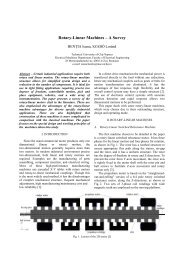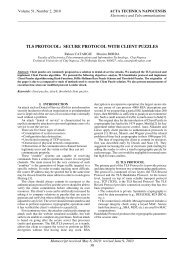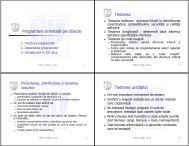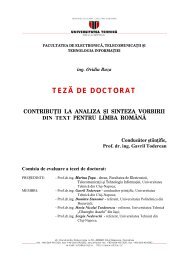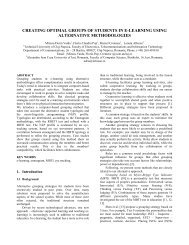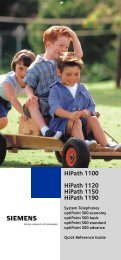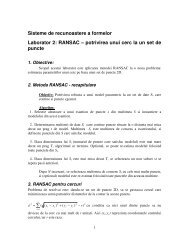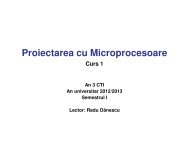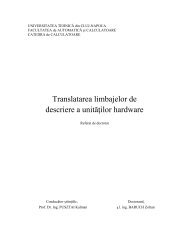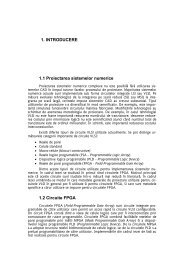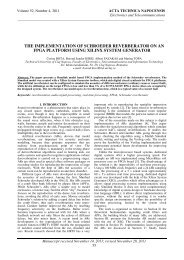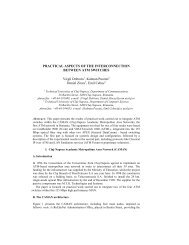LTE Emulator
LTE Emulator
LTE Emulator
You also want an ePaper? Increase the reach of your titles
YUMPU automatically turns print PDFs into web optimized ePapers that Google loves.
TUCN – Data Transmission Laboratory<br />
bit rate, because it emulates only one data stream/user and therefore does not allow the<br />
evaluation of AMBR.<br />
The brief comparison presented above shows that there is a good compatibility between this<br />
version of <strong>LTE</strong> downlink simulation/emulation and the [3GPP07] standard specifications.<br />
6.2. Possible developments of the present version<br />
In the present version of the <strong>LTE</strong> emulator, the physical layer emulation/simulation is<br />
performed only for the downlink direction, the uplink direction being considered ideal.<br />
A first possible development is the emulation/simulation of the transmission in the<br />
uplink direction. The changes which have to be operated at the emulator level are the following:<br />
32<br />
o Reading from the files with statistics of the delay and bit error distributions for the<br />
uplink direction and the generation of tables required for the generation of the<br />
appropriate random variables;<br />
o Delay of packets transmitted in uplink and error insertion in these packets;<br />
Note: the operations which have to be executed for the emulation of the uplink<br />
direction are identical with those executed for the downlink direction, only the<br />
distributions used to generate delays and error packets would be different.<br />
More important modifications have to be made in the simulation program, because the<br />
parameters of the uplink physical layer are different to those that define the downlink physical<br />
layer. The physical layer of the uplink connection uses other types of transmission and access<br />
schemes, of modulation and FEC coding and other frame structures.<br />
Another possible development is the simulation/emulation of the signaling traffic. This<br />
implies modifications both at the level of emulator and simulator.<br />
At the emulator level it requires the separation between data and signaling packets in both<br />
transmission directions. These packets must be separately processed, fact which requires<br />
different appropriate statistics. The emulation of a separate bidirectional channel implies also<br />
more computations and therefore, more powerful computers and a better optimization of the<br />
implementation would be needed.<br />
At the simulator level it would involve the implementation of the processing required by the<br />
transmission of data over the signaling channels and the generation of the file(s) with the<br />
appropriate statistics.<br />
Another important development is the emulation of a multicell configuration, in which the<br />
main user can pass from one cell to other. This emulation would require modifications only in<br />
the emulator. When the main user reaches the edge of the cell or the SNR decreases below a<br />
given threshold, a handover procedure should be called to decide if the emulated users should<br />
connect to the base station of the new cell (considering the load of that cell or some statistics<br />
which describe the handover procedure). If the handover would be possible, this procedure<br />
should choose a new set of delay/error statistics corresponding to the new radio propagation<br />
conditions and cell load. The parameters which describe the new cell in the emulator (see<br />
paragraph 3.1.1.) should also be modified. The block that manages the handover operation<br />
should also generate/emulate the signaling traffic required by this operation.<br />
Other possible developments at the simulator level are the following:<br />
o Simulation of different multi-antenna techniques (MIMO techniques) on both<br />
transmission directions;<br />
o Generation of the test data (test bit streams) used in the simulated transmission according<br />
to some appropriate distributions related to the application (service) associated to the<br />
main user, whose transmission is emulated. The present implementation considers that<br />
both ends of the radio transmission system are equipped with buffers with appropriate<br />
dimensions, which undertake all the variations of the input data stream. For a more<br />
realistic simulation/emulation, it would be necessary to consider in the simulation



